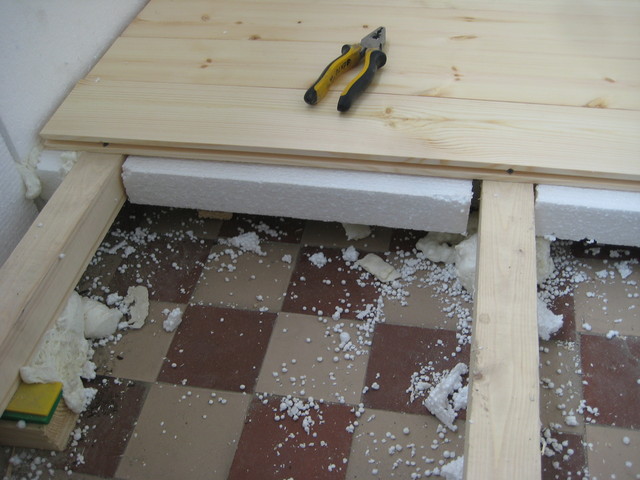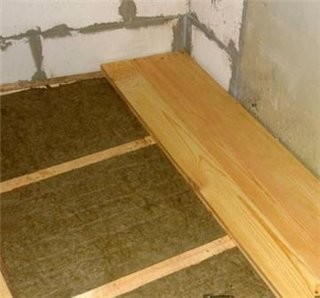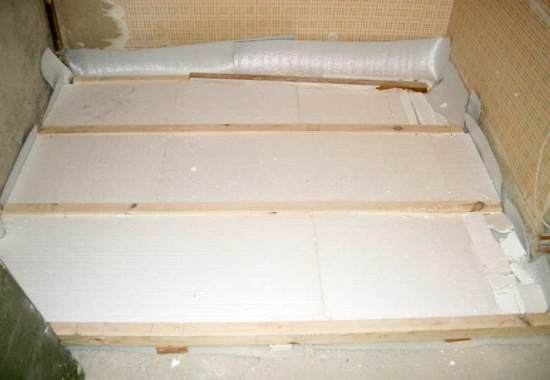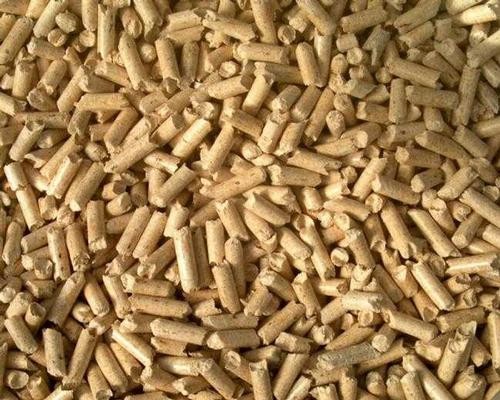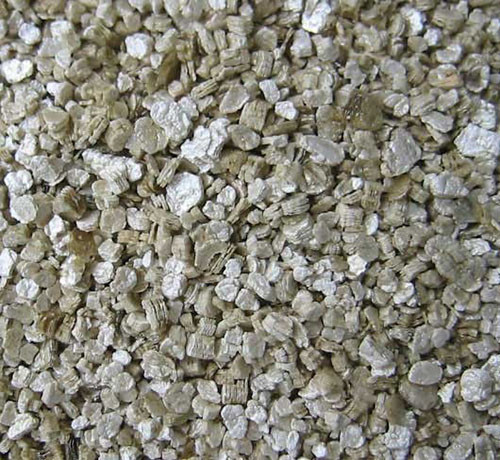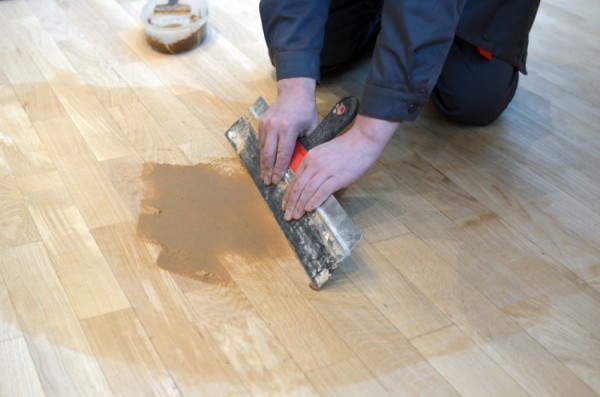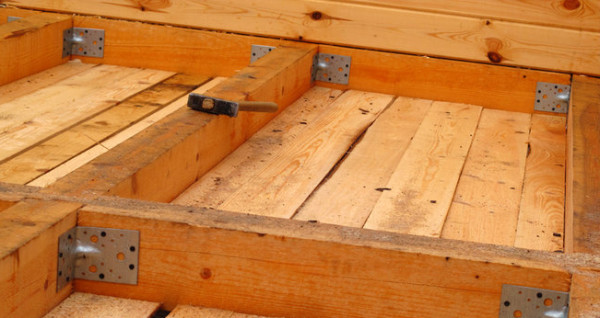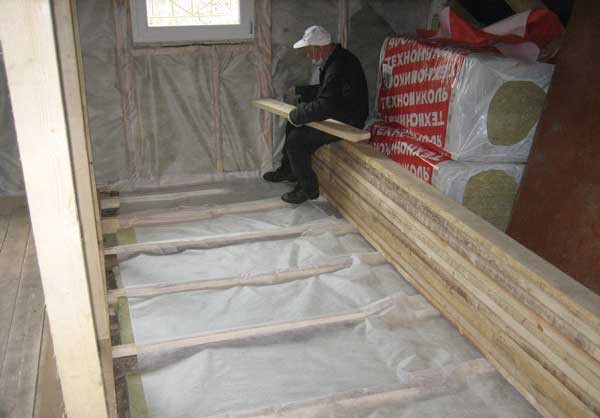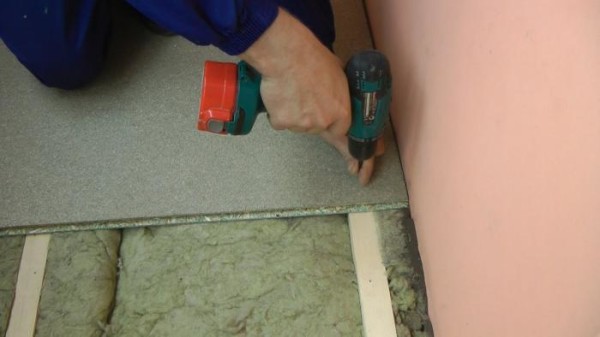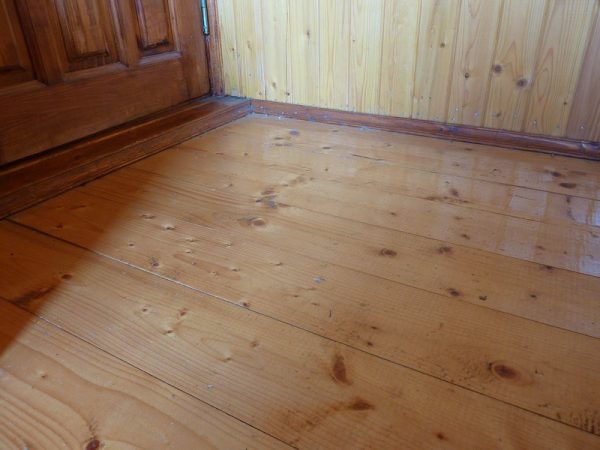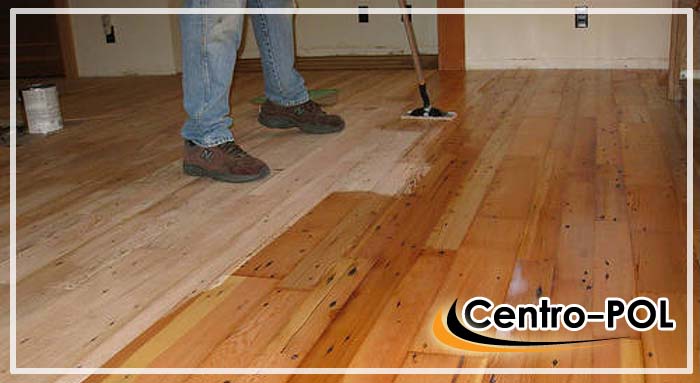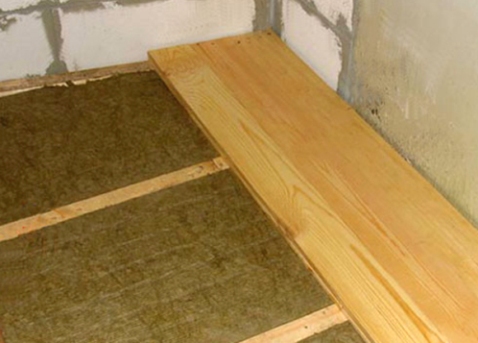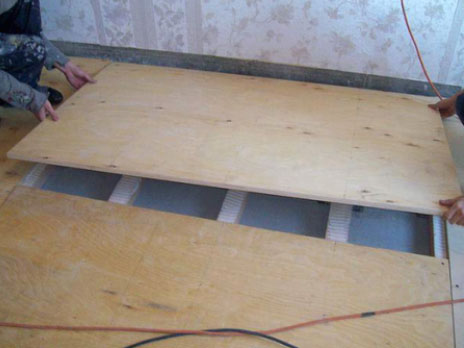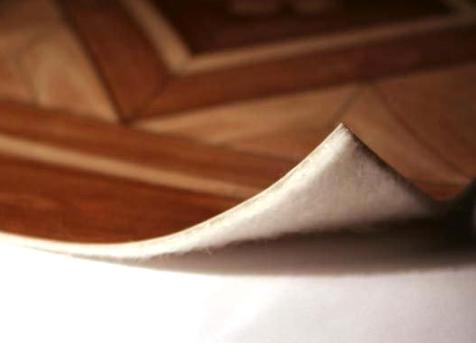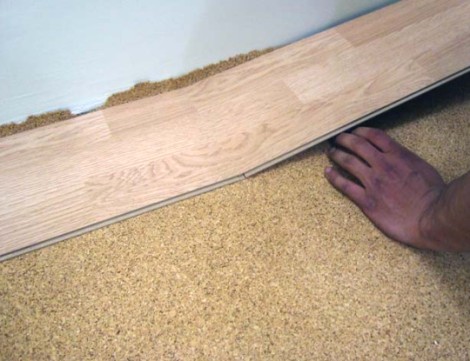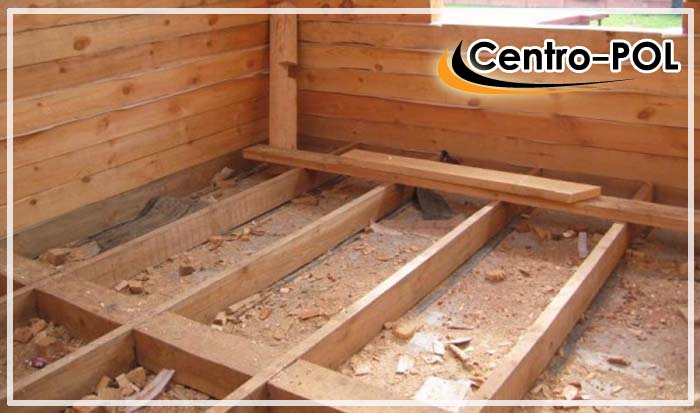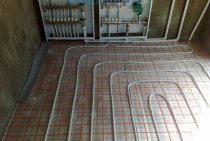Thermal insulation is an important stage of arrangement
Now the insulated floor for summer cottages is no longer a luxury, the owners of modern country houses want to be able to relax there not only in the summer, but also, let's say, comfortably celebrate the New Year.
Contrary to popular belief, it is not so difficult to make insulated floors in the country house with your own hands, the main thing is to choose the right insulation so that later the repair of the floors in the country house does not become regular and does not turn into a kind of hobby.
The market leaders in this case are the following materials:
Mineral wool has a lot of advantages, it is widely used for insulation of walls and ceilings in almost any type of residential or outbuildings.
. It is produced in the form of soft cotton rolls and dense mats. This material does not burn, does not melt and has good heat and sound insulation characteristics. But it also has some serious downsides.
The price of environmentally friendly, water-repellent mats is quite high, and cheaper options will quickly become worthless. In particular, budget options for mineral wool can get wet and lose their qualities. Plus, they dry out and begin to crumble, forming microscopic and very harmful dust. Since the floor is constantly in motion, this dust will spread.
-
Extruded polystyrene foam or, in the budget version, ordinary foam plastic, can be called perhaps the most common type of insulation.
. It belongs to environmentally neutral materials, perfectly retains heat, does not get wet and has decent soundproofing qualities. -
Of the minuses, one can name the fact that it does not allow air to pass through, in other words, it does not breathe and, when exposed to open fire, it can melt and burn
. But this is more true for wooden structures. If country houses are insulated from block containers, then polystyrene foam is the best option.
Expanded clay is currently considered one of the market leaders
. It is completely environmentally friendly, harmless bulk material. It is a natural clay, fired and foamed in special furnaces. As a result, granules are obtained from a solid porous material that are not afraid of moisture.
How to choose floor insulation
Professional builders have been arguing for a long time about the best thermal insulation material for the floor in the country, but in most cases, the owners of their own houses are interested not only in the effectiveness of the insulation, but also in its cost, and it is desirable that it be as low as possible. A warm floor in the country can be made using inexpensive bulk materials, heat-insulating mats or slabs, and if funds allow, you can organize polyurethane foam spraying and forget about drafts forever. There are a lot of heaters on the market, but almost always the choice is based on financial capabilities.
There are a number of requirements for floor insulation:
- Light weight so as not to create an additional load on the foundation.
- Waterproof - the insulation should not pass or pass water minimally, not damp and provide additional waterproofing (ideally).
- Durability - you must admit, no one wants to start such large-scale work to change the insulation every 3-5 years.
- Fire safety - insulation should not easily ignite or support combustion.
- Ecological purity.
If the financial situation allows, you can purchase modern heaters that are easy and quick to install without the help of specialists. There is also a solution for economical owners - traditional insulation schemes using cheap materials, but you will have to tinker with their installation. Consider all options.
Inexpensive heaters
If you want to save on building costs without sacrificing quality, there are several thermal insulation materials that provide reliable protection from the cold and at the same time are inexpensive. For example, our ancestors also insulated floors with dry sawdust. They can be purchased at a minimal price or even obtained for free at a woodworking production. However, in this case, it will be necessary to strengthen the waterproofing, because the sawdust easily absorbs moisture, and when they become damp, they no longer retain heat.
A more practical option is sawdust pellets - this is a product of modern production, the raw material for which is woodworking waste. The sawdust is pressed under pressure into small, hard granules that are not so easily succumbed to moisture and last longer. The granules are treated with flame retardants (means that do not easily catch fire) and antiseptics. Basically, this material is used for thermal insulation of the floor on the ground. In addition, untreated pellets are an excellent economical fuel for stoves and boilers. They are also used as fillers for cat litter, which speaks in favor of their environmental friendliness and safety.
Expanded clay has excellent thermal insulation qualities and is a favorite insulation material for economical builders. These are clay granules foamed under the influence of high temperature, which practically do not absorb moisture and are able to give the house warmth for many years and even decades.
The only drawback of expanded clay is its fragility, so care should be taken during transportation. For high-quality thermal insulation of the floor in the middle latitudes of Russia, it is recommended to pour a layer of expanded clay with a thickness of about 30 cm
Another inexpensive insulation is mineral wool in rolls without a corrugated sheath or foil layer. However, for it, as well as for sawdust, reinforced waterproofing is necessary. The same applies to roll materials based on fiberglass, stone wool, slag wool.
Foam boards are also inexpensive, but they are very fond of spoiling rodents, which sooner or later start up in any private house. In addition, the foam should be protected from fire - and although it does not burn on its own, it emits acrid smoke when melted, which can lead to suffocation.
Expensive modern materials
If you want to carry out high-quality floor insulation in the country and are not constrained by funds, you have a lot of options, one is better than the other.
The most popular modern heaters:
Wood floor insulation
If the floors in the country house are very strong and even, and there is no desire to open them, you can perform insulation directly on the boards. The disadvantage of this method is that the height of the ceilings will decrease by about 8-10 cm.
Tools and materials
For work you will need:
- grinding nozzle;
- jigsaw;
- building level;
- primer;
- putty on wood;
- bars 50x50 mm;
- sheet material, for example, chipboard;
- vapor barrier film;
- insulation;
- self-tapping screws;
- screwdriver;
- construction tape.
The bars will perform the functions of a lag, so they must be even, without defects, and well dried. Since the workflow will take very little time, the bars should be pretreated with antiseptic impregnation and dried.
Floor preparation
Step 1 Carefully remove the baseboards and clean the floor from dust. Check the levelness of the surface with a level gauge.
Step 2. If there are protrusions on the floor, the surface is treated with a grinding nozzle. The gaps between the boards and the recesses are puttied.
Puttying a wooden floor
Step 3. The working surface is covered with two layers of primer mixture, the floor is allowed to dry.
Step 4. The beam is laid out on the floor in parallel rows with a step of 30 cm. The distance from the extreme beams to the walls is 2-3 cm.Using a level and wooden wedges, the bars are set exactly horizontally and screwed to the base with self-tapping screws.
Laying and fastening lag
Step 5. The space between the bars is filled with insulation. Mineral wool and polystyrene are best suited for this. The formed seams need to be blown out with foam.
Laying insulation in the space between the lags
Step 6. The insulation is covered from above with a vapor barrier membrane, carefully straightening the material and fixing the seams between the strips with adhesive tape.
Mineral wool is covered with a membrane
Step 7. The sheet material is cut into squares for convenience and proceed to the flooring. Starting from the second row, the sheets are laid with a joint offset of 20-25 cm. The seams should be minimal, so fit the squares as tightly as possible.
Laying sheet material on logs
Step 8 If you plan to lay boards on top of chipboard, additional processing of the subfloor is not needed. For thinner finishes, it is necessary to putty the joints and sand the entire floor with a sanding attachment. After that, remove the dust, apply a primer and wait until the floor dries.
The described options are the most practical for giving; subject to the technology, it will not be necessary to change the heat-insulating layer for at least 10 years.
Insulated floor in the country will last at least 10 years
Comparative table of floor insulation
Types of materials used in floor assembly
For the construction of floors from natural building materials in the country, the following options are most often used:
- Building material sheet type. This variety includes plywood, chipboard and OSB;
- The board is uncut;
- Lumber from glued laminated timber;
- Boards are folded.
The first two types of material are used in the construction of a rough foundation. In the future, an upper decorative coating will be laid on the draft floor of the basement or first floor, which can be formed from boards, glued laminated timber or seam lumber. The decorative coating is subsequently painted or varnished, as shown in the photo.
In order for the floors to turn out not only beautiful, but also durable, it is important for them to choose high-quality wood of the right species. You can find out which wood species is best suited for assembling a floor by watching a detailed video review attached to the article.
Ways to protect the floor in the country from moisture
The problem with arranging the floor in the country house on a strip foundation
often becomes his protection from dampness coming from the earth. The durability of the floor largely depends on the good ventilation of the subfloor. Therefore, taking care of it begins with a project that necessarily provides for the arrangement of products in the strip foundation. Airways are holes located opposite. They are opened in the warm season and closed for the winter, if the winter use of the country house is expected.
In areas where the water table is high, simple ventilation of the subfloor may not be enough. Vapors rising from the ground impregnate the logs and cause them to rot. Polyethylene film will help to correct the situation. It must be spread under the entire area of \u200b\u200bthe house and covered with a layer of ordinary sand
By following these precautions, the durability of the entire floor structure can be greatly improved.
A columnar or screw foundation, by definition, allows free passage of air. Logs on such a foundation will never rot, but the lack of strapping and a warm mound around the entire perimeter leads to the need for more serious floor insulation.
The device of a wooden floor on the logs with a tongue-and-groove board
If they arrange a wooden floor on the logs and the boardwalk is made with a grooved board, then you can make the floor with your own hands as follows. For the installation of a finishing floor on logs, it is better to use boards interconnected in a quarter, on a plug-in
rail or tongue, these types of connections provide a snug fit for the floorboards.A grooved board differs in its sidewall: one sidewall has a groove, the other has a ridge. To fasten a tongue-and-groove board to a wooden log, nails are driven in at an angle into a corner.
comb and sink the hat a little so as not to disturb the tightness of the connection of the boards.
When laying each next board, for a greater joint density, the board to be laid on the side is knocked out with a small hammer through a wooden block. Do not hit the board with a hammer, especially from the side of the joint, so as not to damage it. use
wooden block. The bar is placed against the board and the bar is struck with a hammer. So the board fits snugly into the ridge with a groove.
The device of a concrete floor in the country
The specificity of floor insulation in a country house with a concrete base allows several ways to produce insulation. The first resembles working with a wooden floor, and the second is suitable only for a concrete base. So, floor insulation with the help of a film and layers of heat-insulating material in the country can be done by hand. The film is laid in one layer, its footage is easy to calculate. In this case, preliminary work is necessary - sealing cracks and chips with a cement screed and putty.
After the surface dries, a wooden frame is adjusted to it. The distance between the beams is up to you, but it is better that it is no more than 80 cm. A film is covered on this base and fastened with a stapler. The space between the bars is filled with heat-insulating material.
The second option for the floor in the country is a little more interesting. First, the floor is leveled with putty or screed. Next, you can lay a layer of roofing material for additional insulation. A heater is laid on it - always in the form of plates. They are glued together to form a single layer. Filling with a screed holds them together completely. After it has dried, the floor covering is laid, depending on your preferences.
concrete floors
In modern construction, wooden floors are used very rarely; they have long been replaced by concrete floors. The main advantage of a concrete floor is low cost, ease of installation, high strength and durability, as well as environmental friendliness and fire resistance.
But there is one big “BUT”, the concrete floor has a high thermal conductivity, which is why even on the hottest days it blows cold. Therefore, it is necessary to cover the concrete floor with a special insulation. You can use the same materials as for the wooden floor on the logs.
A well-dried concrete floor must also be covered with a waterproofing film before laying the thermal insulation layer. The technology for laying thermal insulation with lags is the same as for a wooden floor. It should be noted that when warming along the logs, the floor height will increase by 10-15 cm.
Another good way to insulate concrete floors is to use chipboard. This material is in no way inferior to mineral heaters and is quite often used for insulation in private houses and suburban buildings. Organic insulation materials include wood shavings, moss and sawdust. You can also add straw, small dry grass, reeds, hay, sedge or peat chips.
To protect the chipboard from moisture, the concrete is covered with a polyethylene film with high waterproofing. Then chipboards are laid. In this case, the slabs do not need to be laid close to the walls, keeping a distance of about 1.5 cm. This is necessary so that the slabs do not warp during strong temperature and humidity changes.
The plates are firmly fixed with dowels. After fixing the plates, all joints must be reinforced with a construction mesh and covered with putty, which is mixed 1: 1 with oil paint. Then a plinth is mounted around the perimeter. Linoleum or carpet is laid on the finished structure.
You can insulate the floor in the house with your own hands using "warm" linoleum.This material consists of two layers - a warm substrate and polyvinyl chloride, resistant to chemical and mechanical damage. The substrate of such linoleum is made on the basis of natural felt or synthetic non-woven material. Its thickness is about 3-4 mm.
When laying insulated linoleum, it is cut in such a way that there is a small distance between it and the wall, otherwise after a few days it will warp due to an increase in size as it is trampled down.
The concrete floor can also be insulated with a technical cork, which is practical and durable. It is made from the bark of a cork oak, which is glued together with the resin contained in the cork mass. Such material is 100% environmentally friendly, does not pass water, has high heat resistance and does not burn. But there is also a significant drawback - the high cost.
Isolon is also considered one of the best and most effective heat insulators. It is very easy to insulate the floor with it - you need to roll it out on a well-dried concrete floor, and then proceed with laying the flooring.
Warming the floor in the country is a necessary measure by which you will make your home even more comfortable. It's so nice to sit down on the warm floor with the whole family, when the weather is "non-flying" outside the window, and play, for example, monopoly or twister.
How to perform floor insulation in the country with your own hands without removing the old one
Underfloor heating in a country house is a prerequisite for a comfortable stay in the winter. The funds invested in insulation are compensated by lower heating costs and the absence of colds in the family.
Almost all technologies prescribe the dismantling of the top coating and the laying of mineral fiber or polystyrene foam insulation between the joists of the floor frame. What if the need for thermal insulation of the floor fell on the heating season? The traditional sequence of thermal insulation work with the removal of the coating can create many problems for the owners living in the house.
On construction forums, the owners of problematic cottages offer their options, from which you can choose the most acceptable one.
For floor insulation along the logs, our experts recommend
| Rockwool Light Butts | Baswool Light 35 | URSA GEO M-11 |
Ways to insulate the floor without its preliminary installation
In temperate climates, flooring with oriented strand boards (OSB) is practiced. The coating structure is characterized by low thermal conductivity. For decoration, several layers of colored varnish are applied to the surface. Naturally, the base must be fairly even. As a waterproofing, you can use a fairly dense polymer film, sealed at the seams by heat welding.
In a region with difficult climatic conditions, hydrophobized mineral wool panels of increased density are recommended for floor insulation. In the budget version - extruded polystyrene foam 30 mm thick. The insulation can be closed with any sufficiently strong and moisture-resistant panels; linoleum, laminate or material with identical properties can be used as a front cover.
Mineral wool floor insulation
- Panel stone wool, the thermal conductivity of which is sufficient for the implementation of the most complex projects, is characterized by the stability of working properties, chemical inertness, and a long service life.
- The material is environmentally friendly, so there are no restrictions on the internal insulation of residential premises. It is possible to use semi-rigid panels for insulating concrete screeds under floor tiles.
- Moisture-repellent impregnation of mineral wool panels works quite effectively, but the presence of a damp basement determines the need for film or mastic waterproofing.
More affordable polystyrene foam and expanded polystyrene retain their insulating properties even in a damp environment. To seal the system, it is enough to seal the seams and interfaces with moisture-resistant putty or glue with construction tape.
When choosing a heater, this disadvantage should be taken into account in the first place.
For floor insulation under the screed, our experts recommend
| Penoplex Geo | URSA XPS N-III-L | Ravatherm XPS Standard G4 |
Expert advice
Indeed, the proposed schemes are workable and can be used in the budget version of floor insulation. It should be noted that manufacturers of cheap facing materials continue to use old technologies using phenol-containing components. Savings take place, but it is better to refrain from purchasing cheap panels and heaters at the selection stage.
How thick should modern floor insulation be? It is difficult to recommend volumetric coatings, since raising the floor by only 80 mm significantly affects the reduction in the volume of the room. The low thermal conductivity of both heaters allows the use of plates with a thickness of 20-30 mm. Even with panel cladding, the floor height will increase by only 40-45 mm.
wood floor insulation
The wooden floor often falls into disrepair. If you bought a house or inherited it, you need to meticulously inspect its condition. It happens that a house, quite suitable for decoration and planning, turns out to be resting on half-rotten beams. Perhaps the builders did not impregnate them with a solution that improves the properties of the tree, and over time it became damp. If the floor is not suitable, you need to disassemble it. All boards must be torn off from the base in the form of an overlap of beams. This is laborious work, but it must be done.

The floor in the country is better to impose from new boards. It is better to fix them with self-tapping screws, not nails. They are easier to handle and dismantle. In addition, their fastening will not be a test for the tree, since the hole can be shot with a power tool. Boards should fit snugly against each other so as not to let air in from the basement or underground space. It, by the way, can be filled with a metal mesh to prevent the movement of rodents if they start.

A layer of insulation will provide a warm floor in the country. Install wooden logs around the perimeter of the floor - bars, between which insulation will be laid. The distance between them can be from 40 cm to a meter. A vapor barrier film is laid on them, which is fastened with a furniture stapler. Gaps or gaps should be sealed. Fasten the film at all folds so that it adheres to the joists and the floor. Both polystyrene foam and polystyrene foam are suitable for warming floors in the country. Mineral wool is recommended as a filler for seams and joints. Insulation blocks are easy to cut, crumble and cover, so everyone can handle this job. The layer can be from 5 to 20 cm, depending on whether you plan to live indoors in winter.
The top layer will already become the finish coating, it can be laid from chipboard, wood panels, plywood
Here it is important to level the base so that all the boards are, as it were, on the same plane. Between them, gaps are acceptable, and even necessary, which will allow the material to expand and contract depending on humidity, in its natural mode.
Fastening here should be done carefully so that there are no protruding heads of self-tapping screws or other irregularities on the surface. Such a floor in the country house will retain the heat that will be produced by a fireplace or convector, and will also keep the temperature inside slightly higher than that outside, even during your absence.
Wood flooring installation process
In the process of constructing a wooden floor covering, whether in a country house or in a brick cottage, there is nothing difficult: the work can be done by hand.However, in order to get a beautiful, strong and durable coating as a result of the work, it is necessary to take into account many nuances when performing them, and it is also good to study the theory of laying floors.
In a brick house, a cottage or a small wooden structure, floors can be equipped with your own hands in many ways. Consider the two most popular options:
- Floor covering created on a draft layer and with an additional laying of a layer of insulation (sound insulation), located on a base of soil or on overlapping beams;
- A wooden floor built on a concrete base with an insulating layer.
In country houses, the first option is more often used. Moreover, in this way, floors are created as on the first floor or basement, it can also be used in the arrangement of flooring on different floors of the building.
In the second option, the design of the floor covering is built completely differently and it can be modified and modified to reduce costs. More often, this method is used to make floors in brick cottages, apartments, on a concrete base, it makes sense to lay the floors in the kitchen.
